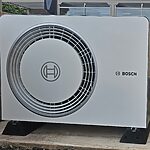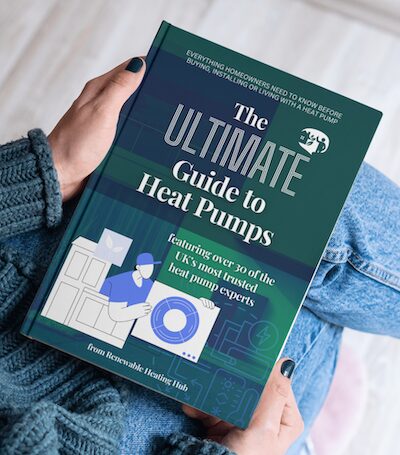Fitting emitters with output greater than room heat loss.
Next year Octopus are fitting a Heat Pump for me. They are changing all the emitters on the ground floor but say the bedroom ones are OK. Of course their design temp is 50C and I hope to run it at a lower temp. With that in mind and the fact that my bedroom emitters are all over 30 years old I intend to have them replaced. I have found K2's that will fit without altering pipework and provide more than enough output to cover the room heat loss. Is it OK to have emitters that have a heat output well above the room heat loss?
Daikin 6Kw ASHP.
MG4 EV
1926 Semi with loft and wall cavity insulation, all radiator.
yes it’s fine to oversize them, you can just limit their output as required with the valves. It gives you some more flexibility as to room use too eg if you use a bedroom as an office.
House-2 bed partial stone bungalow, 5kW Samsung Gen 6 ASHP (Self install)
6.9 kWp of PV
5kWh DC coupled battery
Blog: https://thegreeningofrosecottage.weebly.com/
Heatpump Stats: http://heatpumpmonitor.org/system/view?id=60
Posted by: @jancoldNext year Octopus are fitting a Heat Pump for me. They are changing all the emitters on the ground floor but say the bedroom ones are OK. Of course their design temp is 50C and I hope to run it at a lower temp. With that in mind and the fact that my bedroom emitters are all over 30 years old I intend to have them replaced. I have found K2's that will fit without altering pipework and provide more than enough output to cover the room heat loss. Is it OK to have emitters that have a heat output well above the room heat loss?
If they are all above the required heat loss by about the same amount, you simply turn down the flow temp! If some are 'oversized and some not, it might be difficult to balance the system so the rooms with large radiators may get too hot. I have this situation, all the well oversized ones are in bedrooms, so Im running those rooms (which are a minority) on TRVs with the rest of the system open loop on pure unadulterated weather compensation.
Unless you get the downstairs rads changed to a size that's capable of supporting a lower FT, you will be stuck with the design FT or thereabouts (If it were the other way round then less so because heat rises). If you want to run at a lower FT you may have to find a way to persuade Octopus to fit bigger rads downstairs. You could try claiming that you need warmer rooms (either because you like it warmer or because of a medical condition). They can then design for 50 at the higher room temp and you can run it at a lower FT for a more normal room temp. Rads are anyway cheap so the cost of making them a bit bigger is negligible, the cost driver is the number of rads not their size (unless you need K3s/Type 33s/fancoils).
4kW peak of solar PV since 2011; EV and a 1930s house which has been partially renovated to improve its efficiency. 7kW Vaillant heat pump.
@jamespa Thanks, I have played with Heatpunk and noted the heat losses calculated by BG and Octopus, I reckon the ground floor will run at 45C. However I do not have great confidence in my abilities in this field. 🤔
Though with the present K1's I am comfortable at 20C with the boiler set at 44C flow running 24/7 and OAT of 5C.
The ground floor rads will all be replaced with K2's, plus an extra 600*6oo K2 and 1000 by 600 K3! I fed this into Heatpunk and it said It could work at 44C.
I have had a plumber to quote so I will see what he comes up with.
Daikin 6Kw ASHP.
MG4 EV
1926 Semi with loft and wall cavity insulation, all radiator.
@jamespa Regarding this point you made below. How did you know you had problems with the system's balance? Was it trial and error? Did your heat pump short cycle?:
"If they are all above the required heat loss by about the same amount, you simply turn down the flow temp! If some are 'oversized and some not, it might be difficult to balance the system so the rooms with large radiators may get too hot"
Posted by: @bigvibes! If some are 'oversized and some not, it might be difficult to balance the system so the rooms with large radiators may get too hot"
If the objective is to operate without trvs then rads need to be balanced so that the rooms are at the same temperature (or deviate from the same temp by the desired amount). Lockshield valves are often not great (see heat geek - valve authority). If one or more rads need to be turned down a lot because they are way oversized relative to others, thus will be a tricky adjustment on the lockshields and also risks restricting overall flow rate too much.
In my case I knew some rads were oversized because they were installed before I realised how much the usual assumptions can overestimate loss. If I leave them open the rooms get too hot, confirming what I already knew. No problem with short cycling just some rooms overheating in the way expected.
If it had been practical I would have oversized the second tranche of rads I fitted by the same amount and reduced ft. But doing so would have made them uncomfortably large.
4kW peak of solar PV since 2011; EV and a 1930s house which has been partially renovated to improve its efficiency. 7kW Vaillant heat pump.
Posted by: @bigvibes@jamespa Interesting. Good you got that figured out.
The proof, of course, will be in the heating!
My ASHP was fitted two weeks ago sized based on two years measurements of gas consumption and assumptions about air change rate which are lower than the default - put simply its a significantly smaller capacity than that most (not all) of the installers want to fit. Im pretty confident in the loss determination, but ideally(?) need a couple of cold winters to prove it. So far its running at the ~4kW output (or less) that I expect it to run at most of the time, based on the measured house loss of ~7kW. The pump itself is the Vaillant 7kW model, actually capable of closer to 8.5kW at the design temperatures.
4kW peak of solar PV since 2011; EV and a 1930s house which has been partially renovated to improve its efficiency. 7kW Vaillant heat pump.
I have adjusted the output of all the proposed Radiator changes both mine and Octopus down to delta 25 and the output exceeds the Room loss by 60W to 100W so there seem to be plenty of scope to reduce the flow temp from the 50C of Octopus design. Unless I am missing something. Still no word from my plumber.
Daikin 6Kw ASHP.
MG4 EV
1926 Semi with loft and wall cavity insulation, all radiator.
@jamespa Funny you said you have a Vaillant 7kw. Just today I was asking an installer for a quote on a 7kw Vaillant. I saw on Heat pump monitor than many of the models there are Vaillant. I don't know if that's because a lot of people install them or if they really do perform well. When you say yours is capable of running at 8.5kw how do you get it to run beyond 7kw?
Posted by: @bigvibes@jamespa Funny you said you have a Vaillant 7kw. Just today I was asking an installer for a quote on a 7kw Vaillant. I saw on Heat pump monitor than many of the models there are Vaillant. I don't know if that's because a lot of people install them or if they really do perform well. When you say yours is capable of running at 8.5kw how do you get it to run beyond 7kw?
I don't think that Vaillant are special in any major way, they are one of a number of well-reputed manufacturers all of which reportedly produce good products. They appear to have done a good job of leveraging their existing boiler installer network to build out installer capacity quickly, which may account for their prevalence. They have a good controller (but there are plenty of other good controllers) and a tolerable appearance. They have a reputation for being quiet (judging by mine, justifiably).
One perhaps unique (or certainly rare) feature is the way you enter the WC parameters, which, now I understand it, I think is rather clever. Essentially there are a series of pre-defined curves which you select with a single parameter, all designed on the assumption you want to heat the house to 20C. Then separately you can adjust the target temperature which has the effect of shifting the curves. The genius of this is that an installer can set up the WC and then the householder can change the target temperature, an interface with which they are familiar, without having to understand the WC curves. It makes it possible to offer the householder control based on WC, but with the familiar interface of setting a target temperature. They obviously developed this system for their boilers and have simply applied it to heat pumps. You may have to see it to understand why it is so much better than the typical 4 parameter approach taken by many manufacturers.
Here is the capacity table showing the output at various FT/OAT combinations. As you can see the 7kW model does 8.4 at 45C/-3C.
For what its worth I want particularly 'set' on Vaillant. I first worked out the heat loss, location options and noise constraints and then did a trawl for 'best fit' to these, with a mental 'appearance' rating. Vaillant came out top with Mitsubishi a close second. Had I needed >8.5kW Vaillant wouldn't have been an option, because their next model up is dual fan so correspondingly taller (other manufacturers do single fan up to 12kW) and wont fit under my window.
Hope that helps
4kW peak of solar PV since 2011; EV and a 1930s house which has been partially renovated to improve its efficiency. 7kW Vaillant heat pump.
I had the 7kW Arotherm+ installed a few months ago. It was what the only local installer who made a credible quote offered and my research had revealed that it was one of the better performers. I had almost all the radiators replaced, either because they were old or undersized, and a two more added in known cooler areas. If the performance data provided by the Vaillant app is to be believed that it has more than fulfilled expectations with the worst daily COP so far being 4.8 on 20/21 Nov with a daily mean outside temperature of -0.6C. I didn't scrutinise the detailed data provided by the app but, from the checks I made, the flow temperature didn't exceed 30C. It is remarkably quiet.
The past few days have been around 6C and the COP is around 6. My current target room temperature varies a bit according to a schedule with the highest being 20.5C and it's a degree lower in the day time when we get some warmth from the sunshine when it condescends to shine. The weather compensation algorithm doesn't account for that or when a cold NE wind chills the side of the house that's least well insulated (a horribly big N-facing window). My heat pump is on the S side of the house which I feel helps the performance when the sun shines. Today, at 6C, the pump is running for about 1 hour then stopping for 1/2hr as it can't modulate itself low enough. A disadvantage of the cycling is that the external pipework will lose some heat to the atmosphere. Once it's up to speed on minimum output then it's using about 650W. I think, however, that a lower rated unit would struggle if it's very cold and also take longer to heat the DHW.
- 26 Forums
- 2,323 Topics
- 52.1 K Posts
- 426 Online
- 5,979 Members
Join Us!
Podcast Picks
Latest Posts
-
RE: Replacing my 18 month old Hitachi Yutaki ASHP
@jamespa I’ve re read through the instructions a I can’...
By Sim0n0 , 38 minutes ago
-
RE: Solis S6-EH1P8K-L-PLUS – Why I Chose It and What I’ve Learned So Far
@majordennisbloodnok Thanks. Yes, no problem. Wher...
By Bash , 58 minutes ago
-
RE: Testing new controls/monitoring for Midea Clone ASHP
Here's what mine typically looks like. Hence why I ...
By benson , 1 hour ago
-
RE: Havenwise App Help & Forum Support – Get the Most from Your Heat Pump
@hcas Hello Henri, I know that we have had an exchange ...
By DavidAlgarve , 1 hour ago
-
RE: MELcloud scheduling misbehaviour
@downfield my understanding is that you can have a maxi...
By Richard24738 , 3 hours ago
-
RE: Why Millions of UK Homes Struggle With Heat Pumps
If it is combined with the BUS and they make it all goo...
By Batpred , 4 hours ago
-

RE: Electricity price predictions
Before I dive into the issue of a strategy which helps ...
By Transparent , 6 hours ago
-
RE: Advice on reading thermal images
@editor Thanks Mars, better price from the website and ...
By colinc , 9 hours ago
-
RE: Signenergy AI Mode - How long does it take to learn a usage pattern?
@editor apparently it helps optimise charging and disch...
By Grantmethestrength , 9 hours ago
-

RE: A2A vs A2W: Which Heat Pump Would You Pick?
To be blunt, I wouldn't choose. If we were to move to...
By Majordennisbloodnok , 10 hours ago
-
RE: Diagnostic Data Needed for Repeatedly Failing Tesla Powerwall 3 System
Yes, some queries were raised on github recently: ...
By Batpred , 10 hours ago
-
RE: Share Your Experiences with Heat Pump Manufacturer Support
@cold123456 Mitsubishi has failed to respond to my com...
By Ecoste , 11 hours ago
-
RE: Grant Aerona Short Cycling
@steam-powered I'm currently running 30@-7 23@15 so cur...
By damonc , 14 hours ago
-

RE: What a Bad Heat Pump Installation Looks Like
That's pretty impressively incompetent. In our develo...
By Steelbadger , 22 hours ago
-
RE: Marginal pricing and UK electricity costs
@judith I just realised he’s the guy with the ‘minimum ...
By Lucia , 23 hours ago
-
Midea ASHP Issues with Smart Home App losing connectivity with the Wall Unit
Hi, First Post - replaced out 16 year old gas boiler ...
By SteveT , 24 hours ago
-
RE: Air source heat pump roll call – what heat pump brand and model do you have?
Forum Handle: @lucia Manufacturer: Daikin Model: E...
By Lucia , 1 day ago
-
RE: Heat Pump Training vs. Real-World Installation
@judith I looked at the control challenge of balancin...
By Lucia , 1 day ago
-
RE: Grant Aerona circulation/system pump staying on
@mikefl thank you, I've changed 4200 to 2 and now the m...
By damonc , 1 day ago




